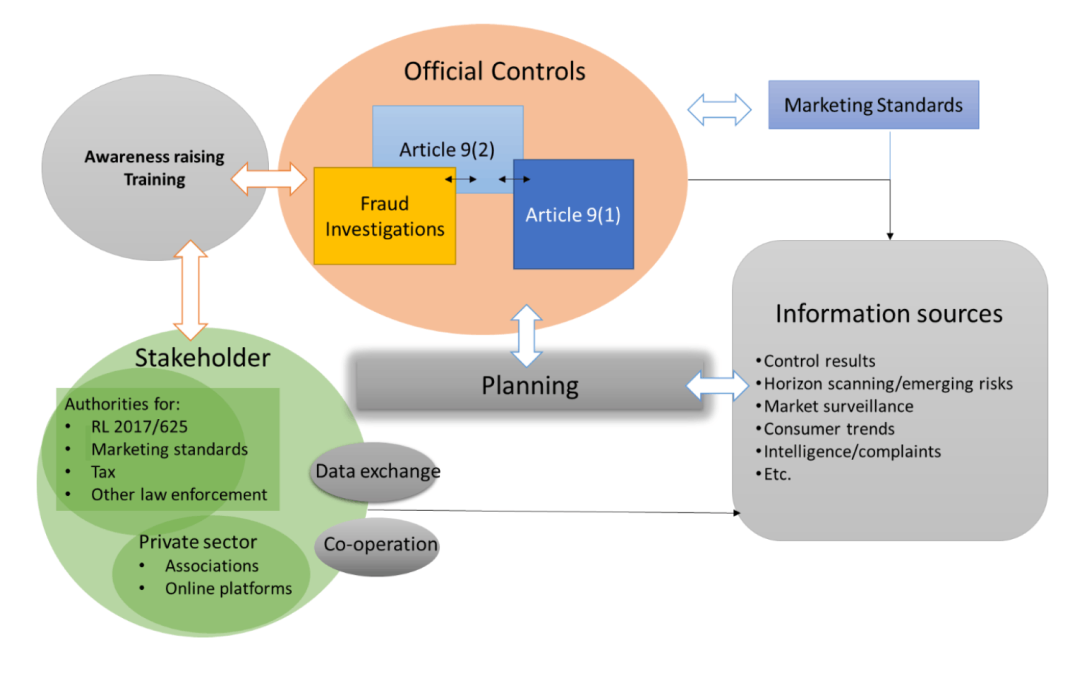Tackling Food fraud: challenges, opportunities and good practices

Food fraud, that is, any intentionally deceiving action consisting in providing false information about the quality and/or content of food products, is an issue of concern for citizens and institutions alike. Beyond the economic loss caused by fraudulent practices, estimated to be in the range between 8 and 12 billion euros per year (KC-FFQ, 2020), there are important health hazards, as adulterated food items may for instance contain allergens that are not listed among their ingredients.
The Joint Research Centre (JRC) of the European Commission recently published a technical report titled “Fighting fraudulent and deceptive practices in the agri-food chain”.
The report is based on a series of studies carried out between 2020 and 2022 in eight different EU member states to identify both good practices and challenges faced by authorities tasked with fraud-related controls, and it presents challenges, opportunities and good practice examples in relation to the implementation of Article 9(2) of Regulation (EU) 2017/625.
The report starts off with an introduction on fraud in the agri-food chain, by explaining the scope of Article 9(2) of Regulation 2017/625, and clarifying that in this context, intention in violating the rules is a core element of food fraud, as opposed to accidental non-compliance due for instance to errors, mismanagement or negligence. The report then highlights the high complexity of food fraud controls, as there are a number of different national and international authorities that have responsibilities in this area. There can be multiple national authorities involved in the process, and they need to cooperate with each other, as well as with their counterparts in other member states, with the private sector, and with a number of European and international agencies including Europol, Interpol, Organisation for Economic Co-operation and Development - OECD. All these actors are expected to work together in detecting suspicious fraudulent activity, despite blurred communication lines.
A central issue is the gathering and sharing of information, pooling together different insights and intelligence.
“While data, if assessed with a sectoral view, may look non-suspicious, the involvement of experts from different authorities and/or control areas may reveal patterns in the data that can hint at fraudulent behaviour and can help to identify high-risk operators (e.g. complex business structures with various activities and locations).”
While incentives such as higher sale prices for quality-labelled products are one of the drivers of food fraud, the other key drivers are opportunities and weaknesses in the control systems. Therefore, the JRC report stresses the importance of vulnerability and risk assessments, as well as that of having well-trained and highly knowledgeable personnel who can detect signals of possible fraudulent practices in agri-food chains. Timely availability of well-structured data, with efforts to close information gaps, are of the utmost importance.
This is precisely where the ALLIANCE project can contribute to preventing food fraud. The main goal of this project is to create a holistic framework that safeguards data integrity and veracity, enhances traceability and transparency, and reinforces interoperability in quality labelled supply chains. Thanks to a blockchain-enabled digital platform, ALLIANCE will enable continuous monitoring of the different phases in the food supply chain, providing real-time information to support early detection and early warning related to food fraud. ALLIANCE will also leverage portable “point-and-shoot” handheld devices that can be used on site for sample testing and for fraud identification, as well as sensors that provide real-time information on a product’s physical attributes. This will provide enhanced screening capacity and the appropriate sensitivity to distinguish authentic from counterfeited (adulterated and diluted) food products. ALLIANCE will also devise a sophisticated methodology encompassing vulnerability risk assessment, as recommended by the authors of the JRC report, supported by AI-driven analytics and statistical tools to facilitate fraud detection.
The implementation of the ALLIANCE project will ultimately help tackle some of the issues outlined in the recent JRC report, increasing transparency in food supply chains, and equipping the relevant authorities and other stakeholders with increased situational awareness, ultimately contributing to the reduction in food fraud. Not only that, but continuous monitoring and more reliable data can also prevent instances of inadvertent contamination or spoilage of food items that, while not constituting fraud in the strictest sense, can also pose risks to consumers.
References:
- Bernd Winkler, Alain Maquet, Elena Reeves-Way, Eva Siegener, Terence Cassidy, Telmo Valinhas De Oliveira, Jurgen Verluyten, Matko Jelic, and Alicja Muznik, “Fighting fraudulent and deceptive practices in the agri-food chain”, EUR 31436 EN, Publications Office of the European Union, Luxembourg, 2023, ISBN 978-92-68-00336-7, doi:10.2760/31366, JRC131525.
- KC-FFQ, (2020). “Food Fraud”. Consulted at: https://knowledge4policy.ec.europa.eu/food-fraud-quality/topic/food-fraud_en
- Federico Iannuli, “Food Frauds: Economic loss and health hazard” 11 March 2023 https://alliance-heu-project.eu/articles/food-frauds-economic-loss-and-health-hazard
- ALLIANCE project glossary, entry “Food Fraud” https://alliance-heu-project.eu/glossary/food-fraud